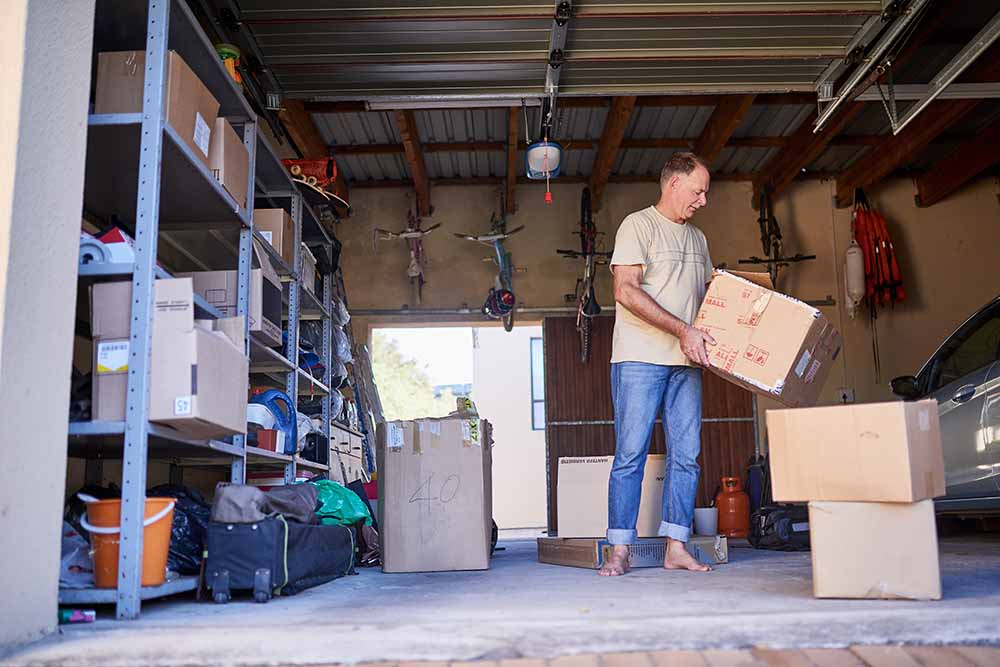
Living in a home with an attached garage should mean never having to shovel off your car after a big snowfall, scrape the windshield on a frosty morning, or slog through sleet, snow, and slush to get to and from your vehicle. And that’s to say nothing of the added security of storing your car in the garage versus in the driveway. It’s ironic, then, that many Canadian garages are so packed to the rafters with sporting gear, tools, storage bins, and so much household detritus that there’s no longer room to park a car.
Given that an attached garage can represent a significant portion of your home’s square footage, it’s no wonder that so many end up jammed with stuff, but if you do want to use your garage for its original intended purpose, here are a few easy ways to make space.
Declutter Add shelving Use overhead space Consider placement Use labels Keep it tidy
Declutter
The less stuff you have in your garage, the easier it will be to make room for the things you really need (not to mention your vehicle). To set yourself up for success, begin your garage organization journey with a thorough decluttering. This process will be different for everyone, but helpful strategies include bringing everything out into the driveway and sorting it into piles to keep, donate, and throw away. Most of us tend to hang onto stuff that we don’t need, so the more unsentimental you can be, the smoother the process will go. If you haven’t used something in years – or better still, forgot you had it in the first place – that’s a good indication that you won’t miss it when it’s gone.
Add shelving
Just like organizing a small living space, the key to making the most of your garage’s square footage is adding shelving to as many of the walls as you can (while leaving plenty of room to get in and out of your vehicle, of course). When it comes to wall-based organization, there are many ways to go, from simple metal standing shelves to custom cabinetry systems with built-in tool storage, power outlets, and mini-fridges. For most people, the best solution will be a combination of wall-mounted shelves, slatwall panels (a modular system of horizontal panels that’s ideal for storing garden tools and sports gear), and freestanding storage.
Use overhead space
Garage shelving isn’t limited to the walls. Depending on how high the ceilings are (and the placement of your door opener) you might be able to fit a surprising amount of storage overhead. There is a wide range of options here as well, from hooks for bikes to racks designed to hold bins and tires. If you opt for overhead storage for heavy items like tires, however, it’s critical to ensure the shelving is rated for the intended load and is safely and securely mounted. And as tempting as it might be to store your tires on an overhead shelf, someone (probably you) is going to have to heft them up and down each season which, depending on your tires, can be a serious lift.
Consider placement
If you’ve done a good job of decluttering, you’ll need to access everything stored in your garage sometime in the next year. When you anticipate needing an item should dictate where it’s stored. In the winter, for instance, keeping your snowblower, shovels, and ice-melting salt near the door will keep you from having to dig them out after the first big snowfall. Likewise, life jackets, coolers, and other summer gear will be just fine on an upper shelf until you need them again.
Use labels
If you’re using plastic storage bins, whether they’re clear or opaque, labeling each one with a general description of what's inside (e.g. gardening tools, beach toys) will make it easier to find what you need when you need it.
Keep it tidy
Now that you’ve done the hard work of decluttering and organizing your garage, your biggest challenge will be keeping the clutter from creeping back in. Helpful strategies for this include being intentional about where you put things (i.e. “a place for everything and everything in its place”) and avoiding leaving anything on the floor. Decluttering tends to be an ongoing process, so plan on doing a full garage clear-out every year or two to stay on top of it.
Jeremy Freed is a freelance writer and editor based in Toronto. His writing about fashion, travel, food and design appears in Sharp, Harry and re:Porter magazines, among many others.